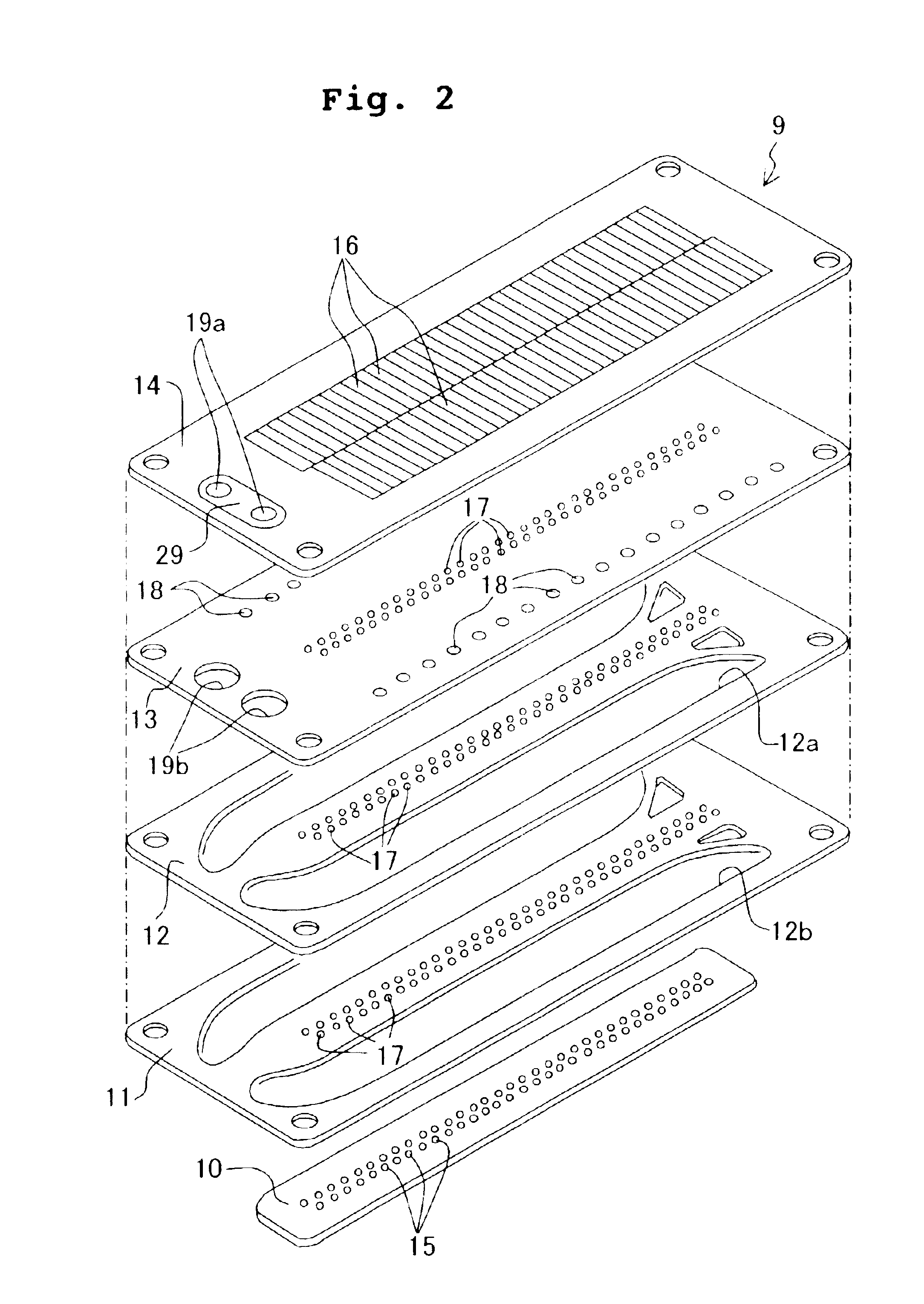Thin plate stacked structure and ink-jet recording head provided with the same
a technology stacked structure, which is applied in printing and other directions, can solve the problems of ink leakage and other problems, and achieve the effect of ensuring the performance of ink-jet printer head, stable adhesive/seal layer, and avoiding liquid leakag
- Summary
- Abstract
- Description
- Claims
- Application Information
AI Technical Summary
Benefits of technology
Problems solved by technology
Method used
Image
Examples
first embodiment
[0056]An embodiment of the present invention will be explained below with reference to the drawings. FIGS. 1 to 7 show a piezoelectric ink-jet printer head according to a first embodiment of the present invention. In FIG. 1, a flexible flat cable 40 is overlapped and joined with an adhesive to effect the connection to an external apparatus on an upper surface of a plate type piezoelectric actuator 20 which is joined to a cavity unit 9 made of metal plates. The ink is jetted downwardly from nozzles 15 which are open on the lower surface side of the lowermost layer of the cavity unit 9.
[0057]The cavity unit 9 is constructed as shown in FIGS. 2 to 6. That is, the cavity unit 9 has such a structure that five thin plates, i.e., a nozzle plate 10, two manifold plates 11, 12, a spacer plate 13, and a base plate 14 are overlapped, joined, and stacked with an adhesive respectively. In this embodiment, each of the plates 11, 12, 13, 14 is made of a 42% nickel alloy steel plate having a thickn...
second embodiment
[0074]A second embodiment of the piezoelectric ink-jet printer head according to the present invention will be explained below. The head and a method for producing the same are approximately the same as those described in the first embodiment except that the air release hole and the release groove of the cavity unit differ in structure as explained below. In the cavity unit, as shown in FIGS. 9, 10A, and 10B, thin width release grooves 34, 35 for the adhesive are formed as recesses on first surfaces of the mutually opposing surfaces of the plates which are disposed adjacently in the vertical direction. In FIG. 9, the release grooves 34, 35 for the adhesive, which are formed on the first surfaces of the base plate 14 disposed at the lowermost layer, the spacer plate 13 disposed at the second layer from the bottom, and the manifold plate 12 disposed at the third layer from the bottom, are arranged so that they are directed upwardly.
[0075]Air release holes 37, 38 are bored at positions...
third embodiment
[0089]A third embodiment of the present invention will be explained below with reference to FIG. 13. FIG. 13 shows shapes of release grooves 142 as viewed in plan view according to a third embodiment. In this embodiment, the respective release grooves 142 are formed by means of the half etching to have a meandering form as viewed in plan view on one surface of each of plates 11 to 14. FIG. 13 shows a case in which the plurality of meandering release grooves 142 are formed to have long dimensions along the long side on one surface of the spacer plate 13. Air release holes 43, which penetrate in the plate thickness direction of the spacer plate 13, are provided at appropriate positions of the release grooves 142. The other constitutive components of the spacer plate 13 are the same as those in the first embodiment. Therefore, the same constitutive components are designated by the same reference numerals, any detailed explanation of which is omitted.
[0090]Few portions of the release gr...
PUM
 Login to View More
Login to View More Abstract
Description
Claims
Application Information
 Login to View More
Login to View More - R&D
- Intellectual Property
- Life Sciences
- Materials
- Tech Scout
- Unparalleled Data Quality
- Higher Quality Content
- 60% Fewer Hallucinations
Browse by: Latest US Patents, China's latest patents, Technical Efficacy Thesaurus, Application Domain, Technology Topic, Popular Technical Reports.
© 2025 PatSnap. All rights reserved.Legal|Privacy policy|Modern Slavery Act Transparency Statement|Sitemap|About US| Contact US: help@patsnap.com



